September 2010
Fri 10th: Pre-season Congress
Sat 11th: First Blunder
Sat 11th: Time for a Benko
Sun 12th: Deja Vu
Sun 12th: Slow Starter
Mon 20th: Grand Prix
Wed 22nd: Club Warfare
Fri 10th: Pre-season Congress
RR normally keeps his chess brain ticking over the summer by attending one or more of the Chester, Hereford, Broadstairs and Berks & Bucks congresses, but for various reasons this summer saw zero congress participation by your hero. Consequently RR has had to survive on the lesser diet of club internal quickplay tournies and friendlies. Thus the Leek congress would provide his first serious chess for nearly 4 months. No doubt at the very least the brickwork of his castle will need re-pointing.
It was with some surprise that RR found himself seeded well into the top half of an U190 section - many of these he had expected to contend with had entered the open in which these posers were allocated 4 figure grades which showed no greater correlation to the players relative strengths than our puny 3 figure ECF ones do.
We join the game in which Simon Chadaway has the white pieces after move black's eighth move.
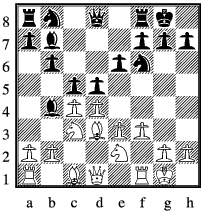
|
| Simon Chadaway v RR after 8 ... c5
|
9 cxd5 cxd4, 10 Nxd4 Bxc3, 11 bxc3 So far the exchanges are following a normal pattern which should be satisfactory for both sides, with white having the bishop pair but an isolated pawn. However RR now declines the obvious Qxd5 and wanders into choppier waters:
11 ... e5, 12 Ne2 (if moved to f5 the knight would be difficult to dislodge without weakening the pawns around the black king.)
12 ... Bxd5, 13 Ba3 Re8, 14 e4 Bc6Had RR taken the d-pawn with the queen, he would not have been faced with a decision as to where to retrea the bishop. The chosen square, preventing Bb5 is possible the worst option as it prevents a frontal attack on the isolated c-pawn. e6 a better retreat, with Nbd7 on hand to repel Bb5.
15 Bc4 (preventable with Be6) Qxd1 not wanting to face Qb3 from white
16 Rxd1 b5, 17 Bb3 Nbd7 keen on freeing the a-rook, but a5 better at exerting some control over white's bishops
18 Rd6 Rac8, 19 Bb4 Bb7 black struggles to unwrap his pieces
20 Rad1 Nc5, 21 Bc2 Na6, 22 Ba5 Nb8, 23 Bd8 (diagram right)

|
| Simon Chadaway v RR after 23 Bd8
|
Now what? At this point RR has to confess to losing patience.
23 ... b4 A feeble attempt to take advantage of the pin on the c-file, which Simon brushes away:
24 Bxf6 gxf6, 25 Ba4 Bc6, 26 Bxc6 Rxc6? (Nxc6 is better, though in truth more a case of less bad)
27 cxb4 RR is now dependent on poor play from white, which was not forthcoming, and whilst the agony was prolonged to move 49, the result was now never in real doubt.
Rewind. Try 23 ... Nbd7, 24 Bxf6 (Rxd7 Nxd7, 25 Rxd7 Bc6, and with the Bd8 about to die white is unhappy)
24 ... Nxf6 and black is still in the game.
But even better would have been 23 ... Nd5, the temporary closure of the d-file giving black the opportunity to completely repel the attack.
Put this one down as a loss but not a disaster.
comment on this article
Sat 11th: First Blunder
Round 2, and RR has white against Matthew Wyza, whose chess has improved dramatically over the last couple of years. The game in brief:
Matthew gave up the bishop pair so that he could harrass my clergy.
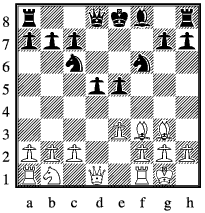
|
| RR v Matthew Wyza after 9 0-0
|
9 ... e4, 10 Be2 Bd6, 11 Bh4 Be5, 12 Nd2 my silicon friend says Nc3 is significantly better than my chosen move
12 ... 0-0, 13 c4 and black has an isolated pawn
13 ...Kh8, 14 cxd5 Qxd5, 15 Nc4 Qe6, 16 a3 (feeble) Rad8
17 Qc2 Rd7, 18 Rad1 Rad1=, 19 Qxd1 I'm sure there was a reason I didn't recapture with the rook, but it escapes me now!
19 ... Ne7, 20 Qc2 Ned5, 21 Nxe5 Qxe5, 22 Rd1 c6
23 Rd2 Ne7, 24 Bg3 Qf5, 25 b4 Ng6, 26 Qc3 Another obscure effort.
26 Qc5 and if 26 ... Qxc5, 27 bxc5 white controls the centre and queenside
26 ... h5, 27 Bd1 with intent to protect f2, but in truth far too defensive with Qc5 still available
27 ... h4,
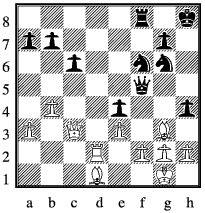
|
| RR v Matthew Wyza after 27 ... h4
|
28 Bc7 clang!! Nd5 Twas precisely this knight move with discovered attack on f2 that I was worried about when retreating my light squared bishop. I seem to have created another way for it be effective. Bd6 is of course safe. No way back from this mistake, thhough I made matthew play it out 'in case'.
comment on this article
Sat 11th: Time for a Benko
RR is much more sparing with the use of the Benko than he used to be, but for some unidentified reason he decided to roll it out when the opportunity arose against Michael Connor in round three.
1 d4 Nf6, 2 c4 c5, 3 d5 b5, 4 Nd2
As with all openings, my knowledge of the Benko is pretty basic, stretching little further than after
4 cxb5 a6, 5 Nc3 axb5, 6 e4 b4, 7 Nb5 do not take the e-pawn.
However I don't recall facing this knight move, so I am out of my book already. Still, I've read somewhere that pins can be pretty nifty, so
4 ... Qa5, 5 b3 bxc4, 6 bxc4 Ba6 (not the most impressive move available. I know I'm going to play d6, so why not play it now and use d7 as a transit square to help development?
7 Qc2 g6, 8 e4 d6, 9 f4 Bg7, 10 Bb2 0-0, 11 Ngf3 Nbd7
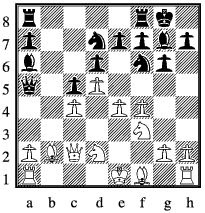
|
| Michael Connor v RR after 11 Nbd7
|
12 Be2 The Benko tends not to produce boring draws, and this game is getting ready to liven up. Understandably Michael wishes to get ready to castle, which will also bring a rook to f1 to aid his attack, but hitting the queen with Bc3 first would have been better.
12 ... Nb6 blocking off the retreat of his own queen, but content to follow up with Qa4 if harrassed by Bc3. Whether RR should be so content is another matter. More to the point
12 ... Nxe4, 13 Bxg7 Nxd2, 14 Bc3 Nxf3+ wins a pawn
13 a4 is the black queen soon to be a damsel in distress?
13 ... Ng4 using the threat of exchange of bishops to rescue the queen
14 e5 closing the long diagonal. Presumably time to move the b6 knight.
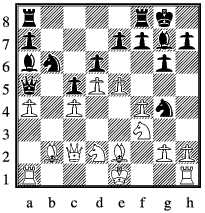
|
| Michael Connor v RR after 14 e5
|
14 ... Ne3 but RR picks the other knight to move. Hope the tactics work as planned. Is this better than Nxc4 and then Ne3?
15 Qb3 Nbxc4, 16 Bxc4 Nxc4, 17 Bc3 Nxd2, 18 Nxd2 Qc7
Yippee! I'm a pawn up, and his king is still in the centre.
19 Nf3 Rab8, 20 Qc2 Qb7, 21 Rd1 Bc4, 22 Qd2 Rfd8, 23 e6 Bxd5 (Qxd5 forces the removal of more material quickly)
24 exf7+ Bxf7 and RR has a two pawn adantage that he refuses to let slip, taking a boring route to victory 18 moves later. Up and running at last.
comment on this article
Sun 12th: Deja Vu
White against Jon Blackburn. Cue the "haven't we played before?" questions. Several times a year it seems. As Jon mentioned that previously I had stomped all over his kingside I declined to go in for my hack attack in favour of the RR pianissimo in which the players let alone any unsuspecting spectators are rapidly sent to sleep.
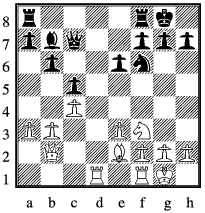
|
| RR v Jon Blackburn after 15 Nf6
|
The diagram shows one of the more exciting positions reached in the earlier part of the game - the discerning reader will understand why the moves leading to it are omitted.
16 Ne5 (Qe5 might give a better chance of an edge)
16 ... Rad8, 17 f3 as long as I can contest the b1h7 diagonal with my bishop I don't think it is that bad a piece
17 ... Rxd1, 18 Rxd1 Rd8, 19 Qc2 the knight is protected by a back rank mate threat even if black removes the rooks first
19 ... d6, 20 g4 Wishing to play for the win RR decides to seriously unbalance the position. However an immediate h5 by black would leave white unable to defend the twin threats against his knight and the kingside pawn structure. Fortunately Jon was still in a fairly soporific mode, and lacked the strength to push the pawn two squares.
20 ... h6, 21 Nd3 exchanging the rooks and playing f4 would have enabled the knight to keep the black queen of the long white diagonal
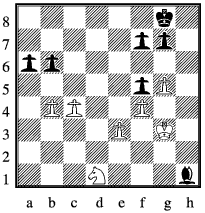
|
| RR v Jon Blackburn after 40 Nxd1
|
After more not quite aimless manoeuvring we exchanged queens on d1 to reach a minor piece ending in which Jon had the bishop in a position with pawns on both wings, but also had the disadvantage of doubled pawns. This sort of equal but different material position is often won by the stronger player. Hope its me.
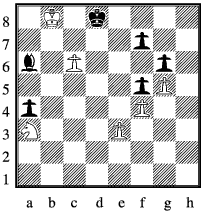
|
| RR v Jon Blackburn after 62 ... Kd8
|
On we ground. By move 62 RR was well up, though still had to be wary of blacks passed a-pawn.
63 Nc4 You don't me to tell you why the knight can be placed en-prise, do you?!
63 ... Ke7, 64 c7 Kd7, 65 Nb6+ effective, though Na5 threatening Nb7 ensures that the c-pawn queens
65 ... Kc6, 66 Nxa4 Kb5, 67 c8Q Bxc8, 68 Kxc8. Black's cause is hopeless, though he continued to move 73 just to check.
comment on this article
Sun 12th: Slow Starter
Alexander Taylor from Newport was lying in wait for RR in round 5. RR had his second white of the day, but a bigger contrast with the morning's game is difficult to envisage. Suffice to say that black's choice of opening went seriously awry - if I tell you that the h8 rook died early at the hands of a knight you'll get he general idea. Instead of embarrassing Alexander with the gory details I'll simply point out that RR twice consciously set up mates and then forgot to play the final moves!

|
RR v Alexander Taylor
RR to play
Spot a mate
|
RR saw it:
1 Rd5+ Kb6, 2 Rb5+ Ka6, 3 Rbxb7+ Ka5, 4 Rb5+ Ka6, 5 Rxf5+ Kb6
6 Rb5+ Ka6, 7 Rbb7+ Ka4, 8 Rg5+ and all black can do is interpose minor pieces. However RR lost his way and played
8 b4 (leading to other mates), and when black unexpectedly played Be6 RR failed to find Ra5+ and Ra6#
Despite this unnecessary prolonging of proceedings, the full point came RR's way shortly afterwards, making three for the congress, a 160 tournament performance, and the sectional slow starter prize.
comment on this article
Mon 20th: Grand Prix
A couple of year's ago I tried to get a strong players longplay tournament off the ground, but it floundered on my inability to attract a sizeable field. This year Alex Richardson launched the Stoke League Grand Prix, a series of linked one night tournaments for the area stronger players. A combination of his extensive contacts amongst the local elite, the one night per event format and hopefully pleasant memories of the league's quickplay jamboree in July led to a healthy turnout of 16 players for the first event. That Simon Edwards was seeded top of the bottom half shows that there was serious playing power out.
RR was included in the field so as to avoid an odd number, doubling his playing with controlling duties. This gave him an excellent excuse for stumbling to 1/5 via two draws - opposing Jonathan Blackburn, Barry Jones, Geoff Lee, Bill Armstrong and John Yee had nothing to do with it!
Going into round 3 Jonathan, Rob Shaw and Mike Hancock had reached 2/2. These three ended up playing a round robin against each other over the final rounds, with each winning their other game against the likes of Alex Richardson, Gerald Acey and Malcolm Armstrong. Easy. Jonathan and Mike came first and second respectively in this mini league, giving a one-two for Holmes Chapel in the event.
The next event in the series should be in November.
comment on this article
Wed 22nd: Club Warfare
Tonight saw the B team take on the C team in the season's opener, brought forward a week from the original date to better suit the players. RR found himself with black against John Day.
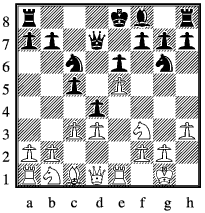
|
| John Day v RR after 10 c3
|
RR was feeling comfortable by the time he was selecting his tenth move as he was already forming plans around the white e-pawn and possibly weak d-pawn. But safety first.
10 ... Be7, 11 Na3 0-0, 12 Re4 a6. Naughty. If John takes the d-pawn now RR is forced to recapture with the c-pawn, removing the opportunity for a frontal attack on white's d-pawn and giving himself an immobile advanced pawn to defend. Fortunately John decided to further increase the pressure:
13 Nc2 dxc3, 14 bxc3 Rfd8, 15 d4 Qc7, 16 Qe2 cxd4
17 cxd4 b5 Unnecessary. Rac8 would be a more rapid way of controlling operations and give less time for John to consider annoying me with h4/h5.
18 Bb2 Rac8, 19 Rc1 Qa5, 20 a3

|
| John Day v RR after 20 a3
|
At this point I'd like to play Qa4 and bring my knight to c4 via a5, but was put off by the threat of the discovered attack d5. However since I could then play Qb3 to good effect, I should not have been worried. Instead, not wanting to retreat the queen I came up with
20 ... h6, which does have virtues of its own. John went into the tank at this point, and with a shortage of obvious options I became convinced that he would the exchange of queens, which in due course he did.
21 Qe1 Qxe1+ cue laughter as he has now to choose which rook or knight to recapture with.
22 Rexe1 connecting the rooks but
22 ... Nf4 and my knights can have a field day
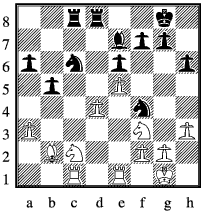
|
| John Day v RR after 22 ... Nf4
|
I'm expecting 23 Re3 Na5, but get
23 Rcd1 Nxe5, 24 dxe5 Rxd1, 25 Rxd1 Rxc2, 26 Bd4 Bxa3
27 Be3 Nd5, 28 Nd4 Nxe3, 29 Nxc2 Nxd1, 30 Nxa3 with RR electing for a simple knight endgame two pawns up rather than the more materialistic N+BvR to go with the two pawn advantage. He made unnecessarily hard work of this ending by allowing the free capture of one of his passed pawns, but eventually ended up in the winner's enclosure anyway.
The match was tied 2½ each, a result that neither team can complain about. Bragging rights will have to wait for the rematch in January.
comment on this article













